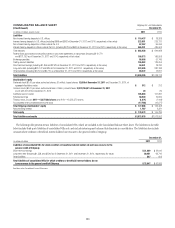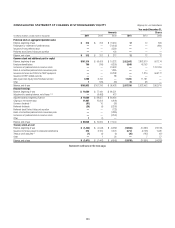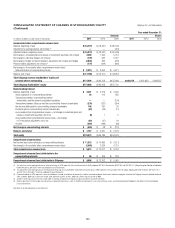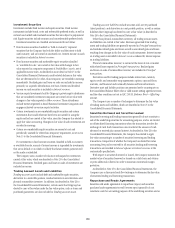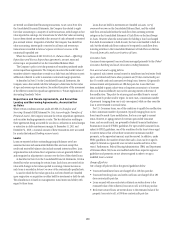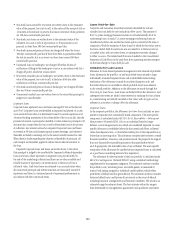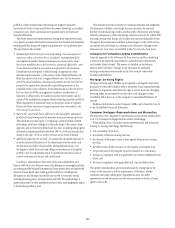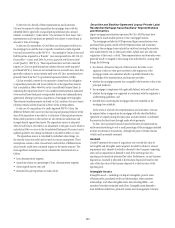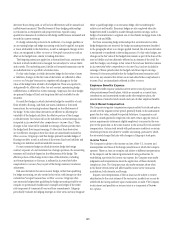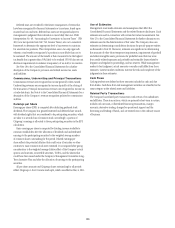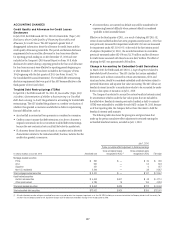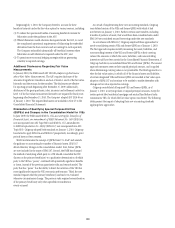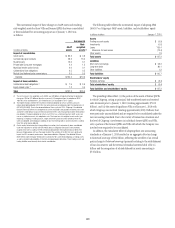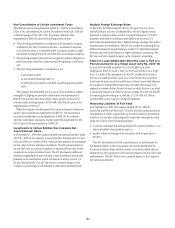Citibank 2011 Annual Report Download - page 162
Download and view the complete annual report
Please find page 162 of the 2011 Citibank annual report below. You can navigate through the pages in the report by either clicking on the pages listed below, or by using the keyword search tool below to find specific information within the annual report.140
Non-bank loans secured by real estate are written down to the estimated
value of the property, less costs to sell, at the earlier of the receipt of title or
12 months in foreclosure (a process that must commence when payments
are 120 days contractually past due).
Non-bank auto loans are written down to the estimated value of the
collateral, less costs to sell, at repossession or, if repossession is not
pursued, no later than 180 days contractually past due.
Non-bank unsecured personal loans are charged off when the loan is
180 days contractually past due if there have been no payments within
the last six months, but in no event can these loans exceed 360 days
contractually past due.
Unsecured loans in bankruptcy are charged off within 60 days of
notification of filing by the bankruptcy court or in accordance with Citi’s
charge-off policy, whichever occurs earlier.
Real estate-secured loans in bankruptcy are written down to the estimated
value of the property, less costs to sell, at the later of 60 days after
notification or 60 days contractually past due.
Non-bank unsecured personal loans in bankruptcy are charged off when
they are 30 days contractually past due.
Commercial market loans are written down to the extent that principal is
judged to be uncollectable.
Corporate loans
Corporate loans represent loans and leases managed by ICG or the Special
Asset Pool. Corporate loans are identified as impaired and placed on a cash
(non-accrual) basis when it is determined, based on actual experience and
a forward-looking assessment of the collectability of the loan in full, that the
payment of interest or principal is doubtful or when interest or principal is 90
days past due, except when the loan is well collateralized and in the process
of collection. Any interest accrued on impaired Corporate loans and leases
is reversed at 90 days and charged against current earnings, and interest is
thereafter included in earnings only to the extent actually received in cash.
When there is doubt regarding the ultimate collectability of principal, all
cash receipts are thereafter applied to reduce the recorded investment in
the loan.
Impaired Corporate loans and leases are written down to the extent
that principal is judged to be uncollectable. Impaired collateral-dependent
loans and leases, where repayment is expected to be provided solely by
the sale of the underlying collateral and there are no other available and
reliable sources of repayment, are written down to the lower of cost or
collateral value. Cash-basis loans are returned to an accrual status when
all contractual principal and interest amounts are reasonably assured of
repayment and there is a sustained period of repayment performance in
accordance with the contractual terms.
Loans Held-for-Sale
Corporate and Consumer loans that have been identified for sale are
classified as loans held-for-sale included in Other assets. The practice of
the U.S. prime mortgage business has been to sell substantially all of its
conforming loans. As such, U.S. prime mortgage conforming loans are
classified as held-for-sale and the fair value option is elected at the time of
origination. With the exception of these loans for which the fair value option
has been elected, held-for-sale loans are accounted for at the lower of cost
or market value, with any write-downs or subsequent recoveries charged
to Other revenue. The related cash flows are classified in the Consolidated
Statement of Cash Flows in the cash flows from operating activities category
on the line Change in loans held-for-sale.
Allowance for Loan Losses
Allowance for loan losses represents management’s best estimate of probable
losses inherent in the portfolio, as well as probable losses related to large
individually evaluated impaired loans and troubled debt restructurings.
Attribution of the allowance is made for analytical purposes only, and
the entire allowance is available to absorb probable loan losses inherent
in the overall portfolio. Additions to the allowance are made through the
Provision for loan losses. Loan losses are deducted from the allowance, and
subsequent recoveries are added. Assets received in exchange for loan claims
in a restructuring are initially recorded at fair value, with any gain or loss
reflected as a recovery or charge-off to the allowance.
Corporate loans
In the corporate portfolios, the Allowance for loan losses includes an asset-
specific component and a statistically based component. The asset-specific
component is calculated under ASC 310-10-35, Receivables—Subsequent
Measurement (formerly SFAS 114) on an individual basis for larger-
balance, non-homogeneous loans, which are considered impaired. An asset-
specific allowance is established when the discounted cash flows, collateral
value (less disposal costs), or observable market price of the impaired loan is
lower than its carrying value. This allowance considers the borrower’s overall
financial condition, resources, and payment record, the prospects for support
from any financially responsible guarantors (discussed further below)
and, if appropriate, the realizable value of any collateral. The asset-specific
component of the allowance for smaller balance impaired loans is calculated
on a pool basis considering historical loss experience.
The allowance for the remainder of the loan portfolio is calculated under
ASC 450, Contingencies (formerly SFAS 5) using a statistical methodology,
supplemented by management judgment. The statistical analysis considers
the portfolio’s size, remaining tenor, and credit quality as measured by
internal risk ratings assigned to individual credit facilities, which reflect
probability of default and loss given default. The statistical analysis considers
historical default rates and historical loss severity in the event of default,
including historical average levels and historical variability. The result is an
estimated range for inherent losses. The best estimate within the range is
then determined by management’s quantitative and qualitative assessment





